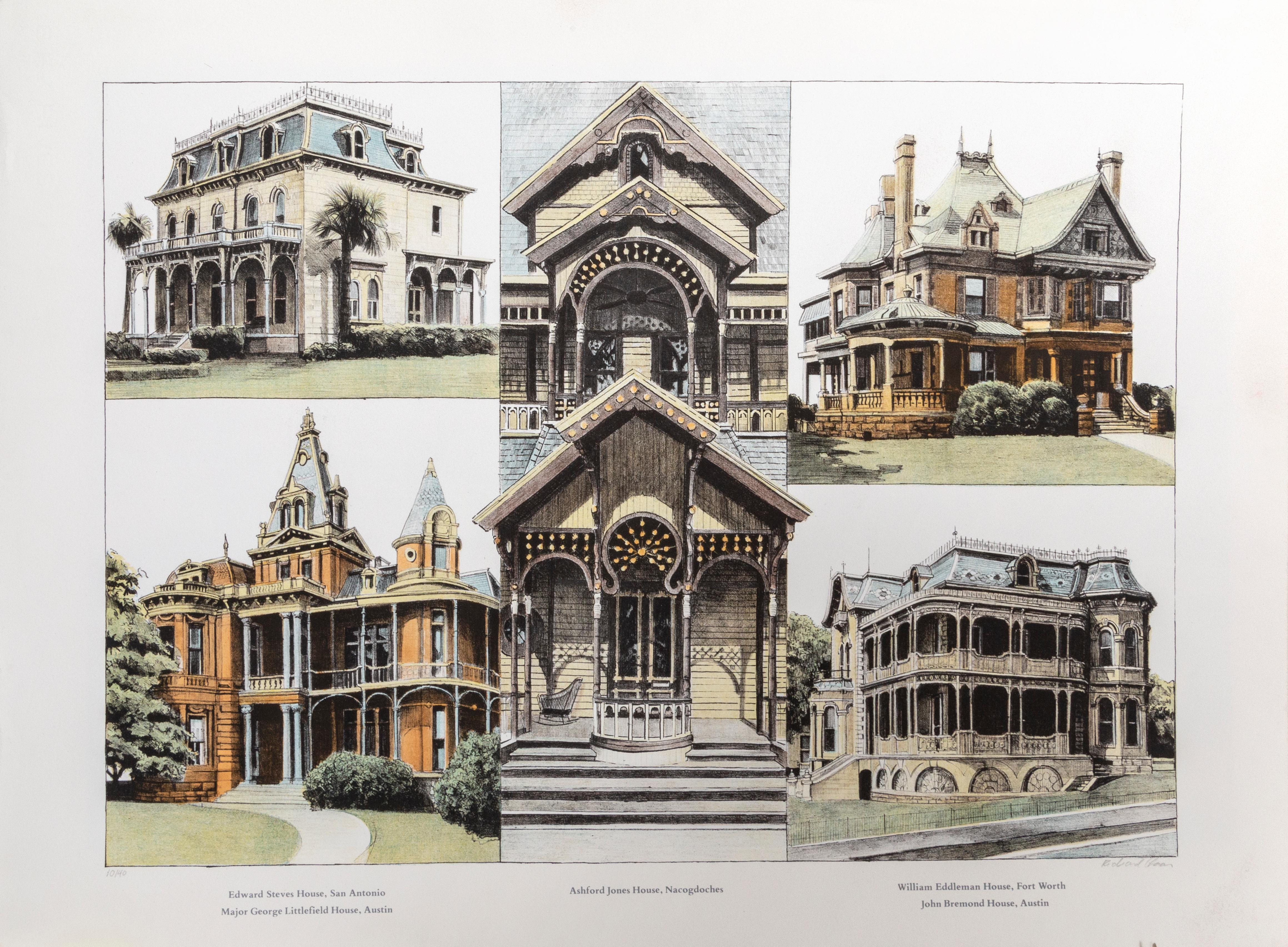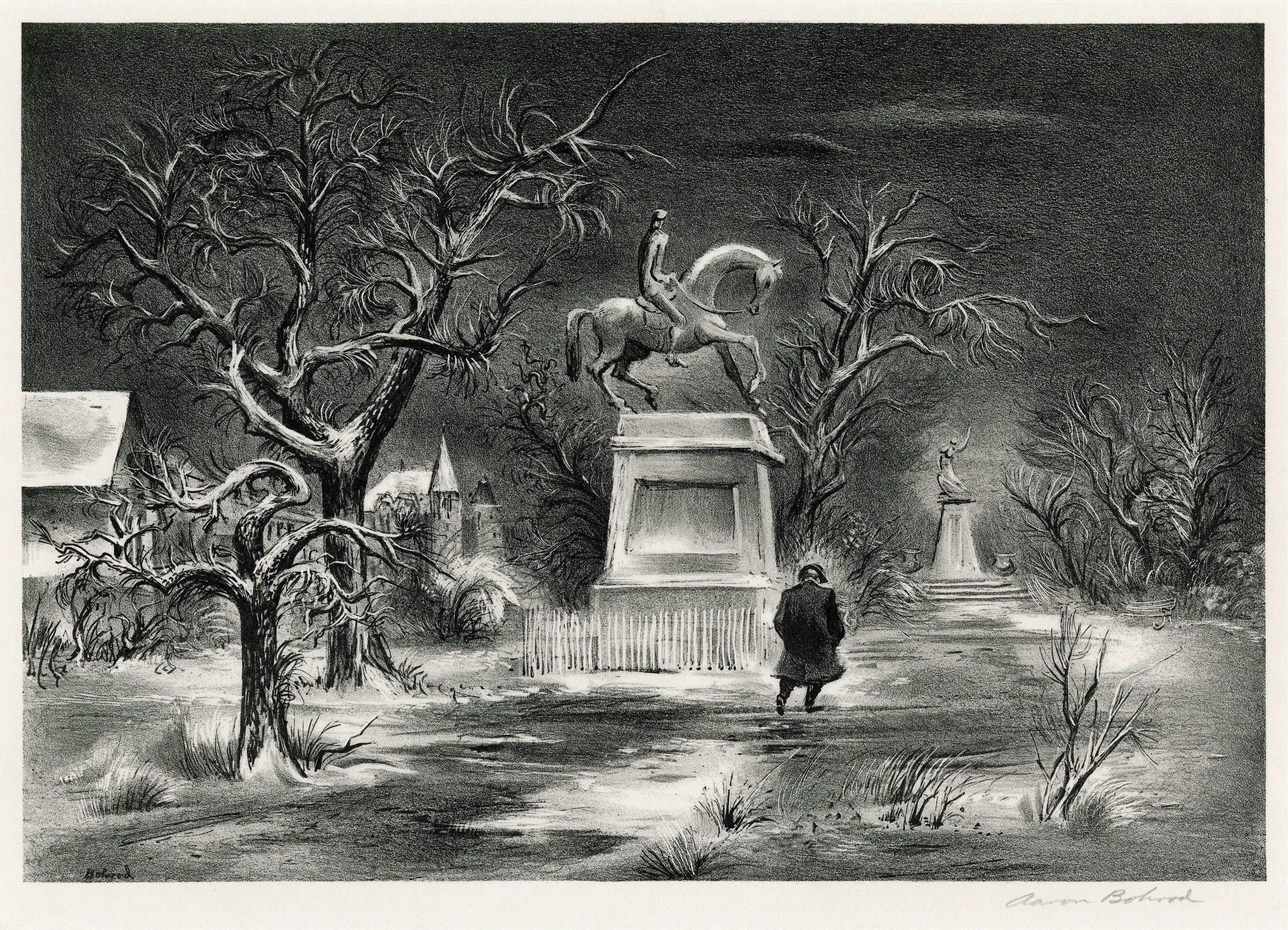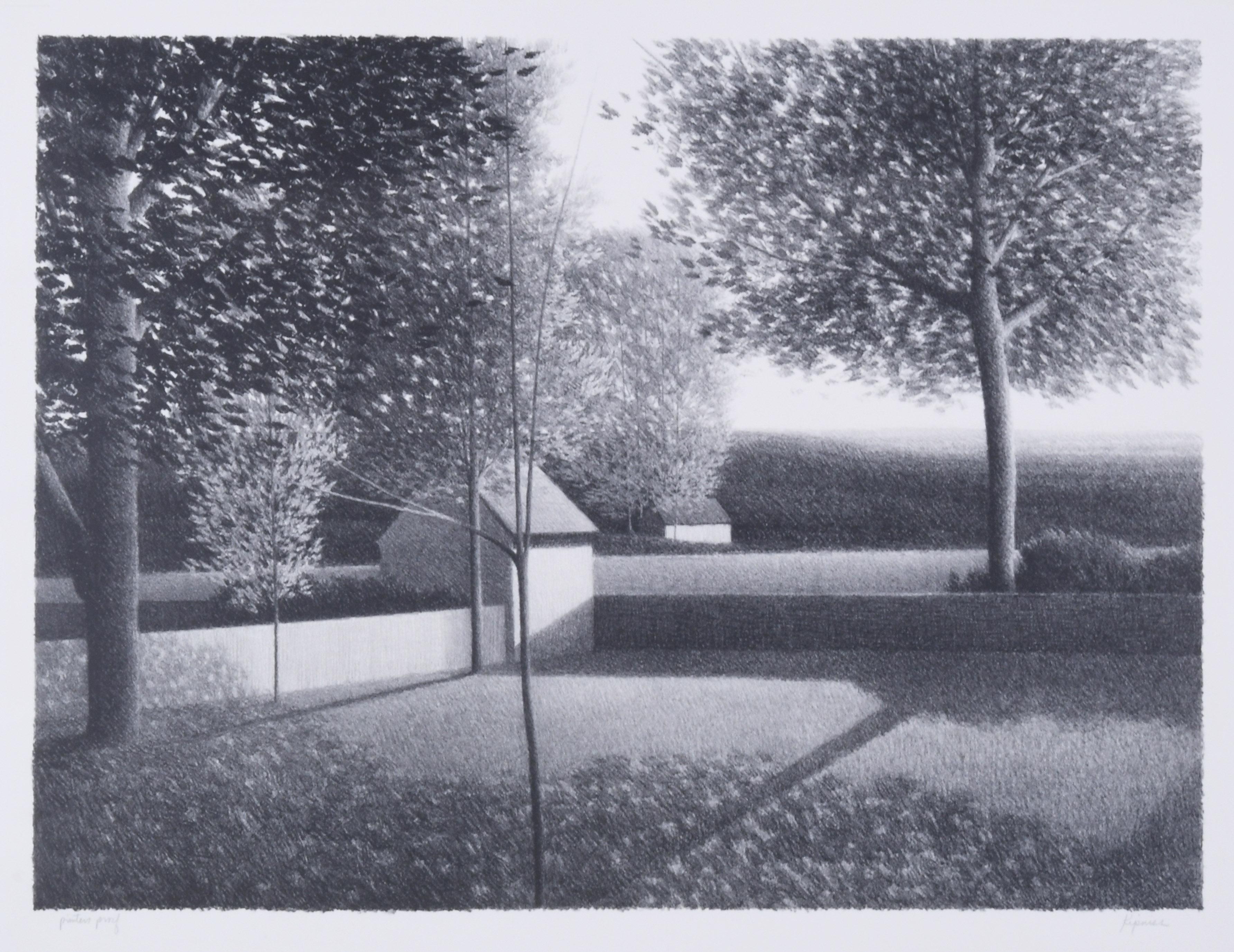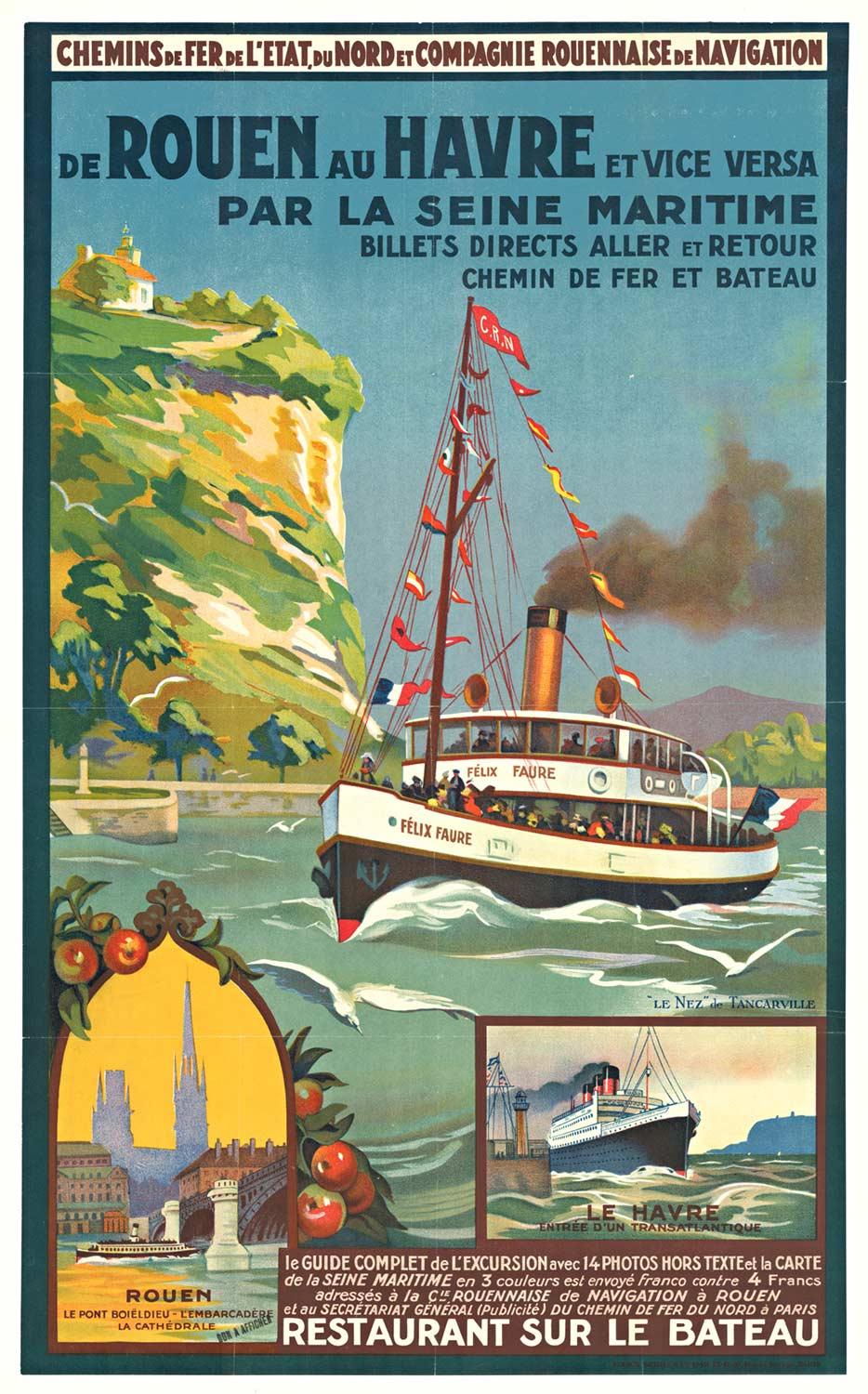Items Similar to The Burning Tower
Want more images or videos?
Request additional images or videos from the seller
1 of 8
Robert A. BirmelinThe Burning Tower
About the Item
Born in Newark, New Jersey, Robert Birmelin became a professor of fine arts at Queens College in New York, and is known for paintings that magnify through texture the realism of nature.
He earned his BA in 1956 and his MFA in 1960 from Yale School of Art and Architecture and also studied at Cooper Union and the Skowhegan School of Painting and Sculpture. In 1960, he earned a Fulbright Scholarship, which took him to the Slade School of Art in London.
His work has been acquired by 40 public collections including New York’s Metropolitan Museum of Art and The Museum of Modern Art and Washington’s Hirshorn Museum. Among the various art magazines and journals where articles on Mr. Birmelin’s work have appeared are Art In America, American Artists, and Art Forum. Additionally, he has received numerous grants and awards from such organizations as The American Academy in Rome, The National Endowment for the Arts, The American Institute of Arts and Letters, and the Joan Mitchell Foundation.
From the 1970s to the mid-1990s, Mr. Birmelin found his principal inspiration in the streets of New York where he was fascinated by the energy and diversity of city life. His large paintings evoke movement, using focus and depth manipulations to suggest a close spatial and psychological relationship between the viewer and the world Birmelin has depicted. Hands often play an important role in these works, as exemplified by “The Twenty Dollars Bill.”
From 1993 to 2000, he became absorbed by memory, its unreliability and contradictions. These paintings are of states of mind, structured as a series of “reversible compositions,” which initially present a credible depiction of a place, and then after a moment, reveal insoluble contradictions created by contrasting opposing images of equal visual weight.
A new series of images of the life of the urban crowd was begun in 2001 and continues to the present. Many of these paintings have a sweeping sense of the choreography of masses of people in motion and reflect the tensions of contemporary urban reality.
Selected Grants and Scholarships
1960-61 U.S. Government Grant (Fulbright) for study in the United Kingdom
1961-64 The American Academy in Rome
1955 National Institute of Arts and Letters
1973 Louis Comfort Tiffany Foundation
1976, 1982, 1990 National Endowment for the Arts
2005 The Joan Mitchell Foundation
1980, 1988, 1998, 2006 The New Jersey State Council on the Arts
Selected Public Collections
Boston Museum of Fine Art, Boston, MA
Brooklyn Museum, Brooklyn, NY
Hirschorn Museum, Washington, DC
Hood Art Museum, Dartmouth College, Hanover, NH
Library of Congress, Washington, DC
The Metropolitan Museum, New York, NY
The Museum of the City of New York
The Museum of Contemporary Art, Nagoaka, Japan
The Museum of Modern Art, New York, NY
National Academy of Design, New York, NY
New York Historical Society, New York, NY
New York Public Library, New York, NY
San Francisco Museum of Modern Art, San Francisco, CA
Smithsonian American Art Museum, Washington, DC
Whitney Museum of American Art, New York, NY
- Creator:Robert A. Birmelin (1933-2003, American)
- Dimensions:Height: 18 in (45.72 cm)Width: 16 in (40.64 cm)
- Medium:
- Movement & Style:
- Period:
- Condition:
- Gallery Location:Surfside, FL
- Reference Number:1stDibs: LU38210565792
About the Seller
4.9
Platinum Seller
These expertly vetted sellers are 1stDibs' most experienced sellers and are rated highest by our customers.
Established in 1995
1stDibs seller since 2014
1,560 sales on 1stDibs
Typical response time: 1 hour
- ShippingRetrieving quote...Ships From: Surfside, FL
- Return PolicyA return for this item may be initiated within 3 days of delivery.
More From This SellerView All
- Brandywine Farm Collotype Lithograph Hand Signed Henriette Wyeth Americana ArtBy Henriette WyethLocated in Surfside, FLHenriette Wyeth-Hurd Hand signed, Collotype, Limited Edition of 490 Image Size: 20" x 26" framed 28.5 X 34.5 Provenance: printed at Triton Press and has their certificate of authenticity verso. Henriette Wyeth Hurd (1907 – 1997) was an American artist noted for her portraits and still life paintings. The eldest daughter of illustrator N.C. Wyeth, she studied painting with her father and brother Andrew Wyeth at their home and studio in Chadds Ford, Pennsylvania. Henrietta Wyeth was born in Wilmington, Delaware, into an artistic family. Wyeth was the eldest of the five children of noted illustrator N.C. Wyeth and his wife Carolyn Bockius. Her siblings Carolyn and Andrew also became artists, and all three studied with their father. Andrew Wyeth became the most well-known artist of this family. Henriette contracted polio at age 3, which altered her health and use of her right hand. As a result, she learned to draw with her left hand and paint with her right. She grew up on the family farm in Chadds Ford, Pennsylvania, and attended local Quaker schools. She and her siblings were eventually homeschooled because their father distrusted the public school system. She began formal art lessons with her father at age 11, making charcoal studies and geometric shapes. A child prodigy, at age 13 Wyeth was enrolled in the Normal Arts School in Boston, Massachusetts. The next year, in 1921, she entered the Boston Museum of Art Academy. Two years later she moved to Philadelphia to study painting at the Pennsylvania Academy of Fine Arts. By age 16, she was well known as a portraitist and received commissions for paintings of Wilmington residents. Deeply influenced by her father's unique realistic style, she rejected early 20th-century painting styles such as Impressionism and Cubism. She was also socially and politically conservative. As a result, later in life she rejected the progressive movements of the 1960s and 1970s, including the women's movement. She often criticized television and modern culture. At age 21, in 1929 Wyeth married artist Peter Hurd, a fellow student at the Pennsylvania Academy and her father's apprentice. The couple had three children together: Peter Jr., Carolyn, and Michael Hurd. In the mid-1930s they moved to San Patricio, New Mexico, settling on a farm of 40 acres. By 1939, they established the Sentinel Ranch there, gradually acquiring more land until they had 2200 acres. It was in southern New Mexico near Roswell, New Mexico, her husband's birthplace. Wyeth's work spanned portraits of adults and children, still lifes, and floral landscapes. In her work, she "often included objects that related to the subject's interest or personality. She eventually stopped painting children because, as she said, “today...Category
1980s American Realist Landscape Prints
MaterialsLithograph
- 4 Animals, American Modernist Abstract EtchingBy Robert A. BirmelinLocated in Surfside, FLBorn in Newark, New Jersey, Robert Birmelin became a professor of fine arts at Queens College in New York, and is known for paintings that magnify through texture the realism of natu...Category
20th Century American Realist Landscape Prints
MaterialsEtching
- The Burning Tower, American Modernist Abstract Landscape EtchingBy Robert A. BirmelinLocated in Surfside, FLBorn in Newark, New Jersey, Robert Birmelin became a professor of fine arts at Queens College in New York, and is known for paintings that magnify through texture the realism of natu...Category
20th Century American Realist Landscape Prints
MaterialsEtching
- Large American Modern Stonehenge Landscape Aquatint Etching Philip PearlsteinBy Philip PearlsteinLocated in Surfside, FLPhilip Pearlstein (American, 1924-2022) Stonehenge Landscape Sugar Lift Aquatint Etching with Roulette on Rives BFK Paper, 1979 Series: Ruins and Landscapes Printer: Orlando Condesso Printer: Nancy Brokopp Medium: Sugar-lift aquatint with roulette Philip Pearlstein is an influential American painter best known for Modernist Realism nudes. Cited by critics as the preeminent figure painter of the 1960s to 2000s, he led a revival in realist art. He is a Distinguished Professor Emeritus with paintings in the collections of over 70 public art museums. Philip M. Pearlstein was born on May 24, 1924 in Pittsburgh, PA. He attended Saturday morning classes at Pittsburgh's Carnegie Museum of Art. In 1942, at the age of 18, two of his paintings won a national competition sponsored by Scholastic Magazine, and were reproduced in color in Life magazine. In 1942, he enrolled at Carnegie Institute of Technology's art school, in Pittsburgh, where he painted two portraits of his parents now held by the Carnegie Museum of Art, but after one year he was drafted by the US Army to serve during World War II. He was initially assigned to the Training Aids Unit at Camp Blanding, Florida, where he produced charts, weapon assembly diagrams and signs. In this role, he learned printmaking and the screenprinting process, and subsequently was stationed in Italy making road signs. While in Italy, he took in as much renaissance art as was accessible in Rome, Florence, Venice and Milan, and also produced numerous drawings depicting life in the Army. In 1946, sponsored by the GI Bill, he returned to Carnegie Institute, and first met Andy Warhol, who was attracted to Pearlstein because of his notoriety in the school, having been featured in Life magazine. During the summer of 1947, the three rented a barn as a summer studio. Immediately after graduating in June 1949 with a BFA, Pearlstein and Warhol moved to New York City, at first sharing an eighth-floor walkup tenement apartment on St. Mark's Place at Avenue A. He was eventually hired by Czech designer Ladislav Sutnar, mainly doing industrial catalog...Category
1970s American Realist Landscape Prints
MaterialsPaper, Aquatint
- Italian Post Modern Pop Art Lithograph Vintage Poster Memphis Galerie MaeghtBy Valerio AdamiLocated in Surfside, FLVintage gallery exhibition poster. Bright vivid red and bold yellow. The Galerie Maeght is a gallery of modern art in Paris, France, and Barcelona, Catalonia, Spain. The gallery was...Category
1980s Pop Art Landscape Prints
MaterialsLithograph, Offset
- Israeli Naive Art Screen Print Lithograph Jerusalem, Sanhedrin Old City Folk ArtBy Gabriel CohenLocated in Surfside, FLBold color lithograph, hand signed in pencil and numbered AP IX/X (artist’s proof 9/10), Jerusalem Print Workshop blind stamp lower right. On French Arches paper. Gabriel Cohen, Self taught, Naive painter was born in Paris in 1933, to parents from Jerusalem with a father who studied the kabbalah. Throughout World War II, the family hid from the Nazis in Paris. Images of Nazi soldiers appear in several of his paintings. In 1949, when Gabriel was 16, the family returned to Israel. They managed to save enough money to move back to the quarter where both parents were born: Ohel Moshe in Nachlaot. Gabriel served in the artillery corps and after the army, went back to live in his parents' house and earned a living polishing diamonds. The head of the polishing plant, who noticed his employee's artistic skill, allowed him to paint during work hours. He once asked Cohen if he could draw a tiger. Cohen drew him a tiger. And he did a lot of sculpting and painting on glass. He also loved to play the guitar, especially flamenco style. Critics say he is one of Israel's greatest naive-style painters. Along with Shalom of Safed, Kopel Gurwin and Natan Heber, He is renowned as one of Israel's greatest living naive-style folk art painters, recipient of the Jerusalem Prize for Art (1987), a permanent entry in encyclopedias of naive painting, who exhibited his work not only in Israel, but also in Paris, Venezuela, Denmark and Germany; the same Gabriel Cohen whose colorful , bold paintings were exhibited at the Jewish Museum in New York in 1987 alongside works by Marc Chagall; the same Gabriel Cohen about whom curator and art scholar Gideon Ofrat says, "There is no questioning his greatness." He has shown in Paris on the Rue de Rosiers in the Marais. His impressions of his journeys, mostly imaginary, yet some real, are expressed in Cohen's paintings. Huge, colorful canvases rich in precise detail and fantasy, in which he paints the Eiffel Tower and the Russian steppes or the vistas of Paris and the Tower of Babel "In my opinion, it's also because the Tower of Babel has some kind of phallic, erotic meaning, but also because of the internationalism, of the mixture and confusion of nations, which is an essential element in Gabi Cohen's work," says Gideon Ofrat. There is no superlative that has not been lavished on Cohen's work by art critics, since he began showing his paintings at age 40, All the art critics seemed to agree at once that Cohen is one of the greatest naive-style painters in Israel. Their counterparts abroad seconded this view. About a year and a half ago, Zadka organized a show for Cohen at the Jerusalem Artists' House. The Tel Aviv Museum bought a painting of Gabi's and so did the Israel Museum, and several artists bought his drawings. He is a great, great painter. There is no painter who is more of a symbolist and illustrative artist than he is. As a painter myself, I admire him." The Yom Kippur War in 1973 sparked an artistic breakthrough for Cohen; it was at that time that he began to sit on the sidewalk after his work as a diamond polisher and paint. Not long afterward, in early 1974, he did a painting he called "Moses on the Mountain." Ruth Debel, of the Debel Gallery in Ein Kerem, passed by and saw it on the street. She asked how much he wanted for it, and for the first time in his life, he realized that his work had financial value. His first show was at the Debel Gallery in 1974. The response was overwhelming. Cohen was immediately declared a genius. His paintings at the gallery were purchased and he continued to create new paintings. That same year, he was invited to take part in a group exhibition of naive artists at the Kunsthaus in Zurich, and a year later, his work was included in a traveling show of naive-style artists from Israel that was exhibited in Denmark and Germany. Soon after that he was invited to be part of group shows in Venezuela and at the Tel Aviv Museum. Cohen had four solo shows at the Debel Gallery. Awards And Prizes 1987 Jerusalem Prize for Painting and Sculpture 1999 Shoshana Ish-Shalom Prize for special contribution to art, Jerusalem He has exhibited alngside all of the Israeli great artists. including Naive Art Group exhibition Gvanim Art Gallery, Jerusalem Rubin, Rachel Roman, Yitzhak Zarembo, Leah Moscovitz, Shalom (of Safed) Steinberg, Michael Danisov, Salva Harbon, Haim Cohen, Gabriel Chanannia, Joseph (Jojo) Local Hero...Category
20th Century Folk Art Landscape Prints
MaterialsScreen, Lithograph
You May Also Like
- Houses, Photorealist Lithograph by Richard HaasBy Richard HaasLocated in Long Island City, NYArtist: Richard Haas Title: Houses, Texas Year: circa 1980 Medium: Lithograph, signed and numbered in pencil Edition: 10/40 Image Size: 17.5 x 24 inches Paper Size: 21.5 x 29 in. (5...Category
1980s American Realist Landscape Prints
MaterialsLithograph
- July FifteenthBy Grant WoodLocated in Palm Desert, CA"July Fifteenth" is a lithograph from 1938 by Grant Wood. The artwork size is 9 3/4 x 12 1/2 inches. The framed size is 17 x 19 1/2 x 5/8 inches. The piece is signed in pencil, lower...Category
Early 20th Century American Realist Landscape Prints
MaterialsLithograph
- City Park, WinterBy Aaron BohrodLocated in Fairlawn, OHCity Park, Winter Lithograph, c. 1947 Signed in pencil lower right (see photo) Published by Associated American Artists Printed by George C. Miller, New York Edition: c. 250 In the Bohrod papers at Syracuse University, the artist states that it is a view of Pittsburgh. It depicts the George Washington Monument in Allegheny Commons Park, dedicated in 1891. The sculptor f the monument is Edward Ludwig Albert Pausch (1856-1931). Condition: Excellent Image size: 9 1/4 x 13 7/16 inches Frame size: 19 x 23 inches Provenance: Estate of Adolf Dehn Reference: AAA Index No. 848 Aaron Bohrod (21 November 1907 – 3 April 1992) was an American artist best known for his trompe-l'œil still-life paintings. Education Bohrod was born in Chicago in 1907, the son of an emigree Bessarabian-Jewish grocer. Bohrod studied at the School of the Art Institute of Chicago and the Art Students League of New York between 1926 and 1930. While at the Art Students League, Bohrod was influenced by John Sloan and chose themes that involved his own surroundings. Career He returned to Chicago in 1930 where he painted views of the city and its working class. He eventually earned Guggenheim Fellowships which permitted him to travel throughout the country, painting and recording the American scene. His early work won him widespread praise as an important social realist and regional painter and printmaker and his work was marketed through Associated American Artists in New York. Bohrod completed three commissioned murals for the Treasury Departments Section of Fine Arts in Illinois; Vandalia in 1935, Galesburg in 1938 and Clinton in 1939. During World War II, Bohrod worked as an artist; first in the Pacific for the United States Army Corps of Engineers' Army War Art Unit...Category
1940s American Realist Landscape Prints
MaterialsLithograph
- Backyard IIBy Robert KipnissLocated in Fairlawn, OHBackyard II Lithograph, 1972 Signed lower right Signed lower right Annotated: Printer's Proof Reference: Karl Lunde 58 An impression is in the collection of the Art Institute of Chic...Category
1970s American Realist Landscape Prints
MaterialsLithograph
- Original "de Rouen au Havre' vintage travel by ship vintage posterLocated in Spokane, WAOriginal Linen backed vintage travel poster. De Rouen au Havre et vice versa par la Seine Maritime. Billets directs aller et retour Chemin de Fer et Bateau. Chemins de Fer de L...Category
Mid-20th Century American Realist Landscape Prints
MaterialsLithograph
- Woodland (New Hope, Pennsylvania)By Stow WengenrothLocated in Fairlawn, OHWoodlands (New Hope, Pennsylvania) Lithograph, 1950 Signed by the artist in pencil lower right (see photo) Annotated: Ed/55 in pencil by the artist lower left (see photo) Edition: 55...Category
1950s American Realist Landscape Prints
MaterialsABS, Lithograph





